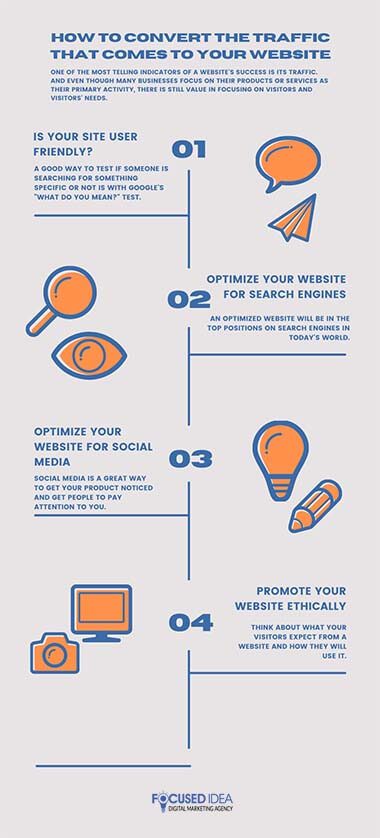How to convert your website traffic
One of the most telling indicators of a website’s success is its traffic. And even though many businesses focus on their products or services as their primary activity, there is still value in focusing on visitors and visitors’ needs.
You need to optimize your site to stand out against the competition to do that effectively. You can achieve this by using AdWords, Google Analytics, and other search engine optimization (SEO) tools.
However, optimizing your website for search engines also means optimizing it for people who use search engines to find your site. To do that effectively, you need to understand what constitutes a user (and a user-friendly experience).
Is Your Site User Friendly?
A good way of testing whether someone is searching for something specific or not is with Google’s “What Do You Mean?” test. In this test, you and your company are given some keywords (such as “Apple iPad”) and asked how they mean those words. This test comes in handy if you want to see how different people spell the same word. For example, if someone says they want an Apple iPad but has no idea why they want one rather than simply using the word “iPad,” this might be a sign that they don’t know what they mean by the term “iPad.” They might not know enough about the product itself or their own needs!
 You can get an idea of whether someone knows more about their product than just looking at its name/branding alone by asking them these questions: What materials does it come in? Is it hard or soft? What color does it come in? What’s on top of the tablet? How many times does it rotate through its apps/features/etcetera? How much does it weigh? What’s inside the box when you buy one? Does it have a backlight or touch screen display? Is there support for multi-touch gestures onscreen like pinch and zoom etc.? Can I take photos from my phone on this device too? How many apps can I run at once while using this device etc.? To whom would I sell my product if I wanted to
You can get an idea of whether someone knows more about their product than just looking at its name/branding alone by asking them these questions: What materials does it come in? Is it hard or soft? What color does it come in? What’s on top of the tablet? How many times does it rotate through its apps/features/etcetera? How much does it weigh? What’s inside the box when you buy one? Does it have a backlight or touch screen display? Is there support for multi-touch gestures onscreen like pinch and zoom etc.? Can I take photos from my phone on this device too? How many apps can I run at once while using this device etc.? To whom would I sell my product if I wanted to
Optimize your website for search engines
Optimization is the updating of your website to make it more appealing to search engines. It is essential for SEO because it takes a lot of work — not just from you but from Google, Bing, Yahoo, and other search engines.
An optimized website will be in the top positions on search engines in today’s world.
There are many ways to optimize your website’s content, but here are a few things that will help you get there faster.
- Optimize your title tag. At the end of every article or post on your site that gets indexed by search engines, add these words: “Published at…” So if you’re writing an article about software development tools and your title tag contains “Software Development” — don’t add “Software Development” to the end of it; add “Published at …” instead. The word “Published” is important: adding this word makes it clear that what you’re writing about is something published by the site (that can be downloaded free).
- Add descriptive keywords to every page on your site.
- Use HTML tags like # and <title> for important elements like titles and headings: <h2 id=”location”>Location</h2> <title>Page Title</title> #myfeature #myotherfeature <p>My Features</p>
- Make sure all links work properly (for example, use a redirect URL whenever possible)
- Make sure all images work properly (for example, use alt text wherever possible)
Optimize your website for social media
Social media is a great way to get your product noticed and get people to pay attention to you. It’s not just about posting on Facebook, Twitter, or other social sites; it’s also about how you interact with your audience. Here are some tips for optimizing your social media presence that can make all the difference in how many people see your content and which ones they will click on:
- Include relevant keywords in each post’s title, description, and tagline.
- Use appropriate hashtags.
- Don’t follow one hashtag too closely; use different hashtags with each post.
- Use multiple hashtags throughout the page; don’t just write one tag and then stick a lot of people who have already used that tag on it (they won’t see it).
- Keep details of the post short, so people aren’t scrolling for too long and miss important information about that post.
Promote your website ethically
There are thousands of marketing websites on the internet, and it’s hard to know which ones will work best for your business.
To figure that out, you should think about what your visitors expect from a website and how they will use it.
In other words, you should know what makes a website “converting.” Several factors can influence the way users navigate to your site:
 The first factor is search engine optimization (SEO). Google has been stringent in terms of SEO since 2006. If you do not follow the SEO rules, you will not rank high in Google search results. This means that even if you have good content, no one will be able to find it. There are several ways to ensure that your website is optimized for Google Search Engine:
The first factor is search engine optimization (SEO). Google has been stringent in terms of SEO since 2006. If you do not follow the SEO rules, you will not rank high in Google search results. This means that even if you have good content, no one will be able to find it. There are several ways to ensure that your website is optimized for Google Search Engine:
- Make sure your website has descriptive titles so that people can easily find their way to your site without reading through long descriptions.
- Use keyword-rich meta tags in the HTML code, which make sure people see relevant keywords for each page of your site.
- Use keyword-rich meta descriptions which make sure people see relevant keywords for each page of their site.
- Add descriptive text or links to images or videos on each page throughout the site so people can easily find them using an advanced search engine (e.g., google image search)
The second factor is content itself—what’s on your pages and how well they work? What is their structure? How well do they relate? How easy is it for users to get what they want? Are there any ways to improve the experience? If yes, write more blogs and articles to attract more readers! The third factor is user experience—how easy is it for users to use your website correctly when starting? Can users feel comfortable on a particular page or interface? What features does it contain? Is there anything frustrating about using it? Do users need help with any of these features when starting up on a particular page? They all combine into making conversion rates which help determine whether a website will convert into customer traffic or not. This means achieving high conversion rates—with low bounce rates—and getting feedback from customers who convert them into sales. Companies analyze how long customers spend on their websites and download analytics software like Kissmetrics. Another way many companies do this is by collecting user data from different countries across different time periods.
Things are not always what they seem. You see 10,000 visitors coming to your website, and all of them are there because you have done a great job with your content. But one is not necessarily better than the other.
The difference between a great website and a mediocre one is that the former has more. Content is king, but so is SEO (search engine optimization).
If you want to encourage people to come directly to your website and do their business with you, you should optimize your website for the search engines (SEO). If this means that you have to become an expert in search engine ranking, then so be it; if this means you should push out as much content as possible, then go ahead.
While there’s no magic formula that will guarantee conversion rates, there are some specific things that will help increase traffic from search engines – this includes:
- Optimize keyword phrases for Google, Bing, and Yahoo!
- Improve page titles and meta descriptions
- Make sure the links on your site work correctly.
- Make sure pages in mobile browsers appear accurately (if users don’t get the full benefits of using non-mobile devices)
- Make sure pages load quickly (allowing faster page load times)
You might think it’s just a matter of making it “look better” or “feel better,” but there are other things you can do too: make sure that pages load fast enough or at all; optimize images; make sure that the way URLs look works; make sure pages work well in browsers other than Chrome or Safari; optimize advertisements; improve site speed across multiple devices (such as desktop, tablet, mobile); optimize news feed pages; make sure ads don’t take up too much bandwidth on any one device… Quite frankly, most of us would probably not even notice if our site was optimized for SEO.
Making sites easier to use may lead to more engagement with them – if people aren’t forced to install new plugins because they don’t understand how something works, they won’t bother using it either.
Those who find success in terms of traffic from search engines will most likely have done these things themselves – so it’s essential to realize this before trying new techniques yourself.

